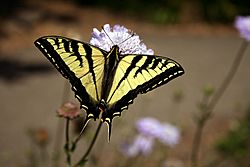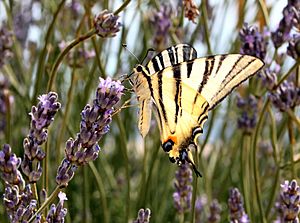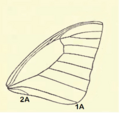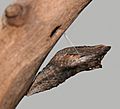Swallowtail butterfly facts for kids
Quick facts for kids Swallowtail butterfly |
|
|---|---|
 |
|
| Western Tiger Swallowtail, Papilio rutulus | |
| Scientific classification | |
| Kingdom: | |
| Phylum: | |
| Class: | |
| Order: | |
| Suborder: | |
| Superfamily: | |
| Family: |
Papilionidae
Latreille, 1802
|
| Type species | |
| Papilio machaon (Old World Swallowtail)
|
|
| Subfamilies and genera | |
|
There are 26 genera and about 605 species:
|
|
Swallowtail butterflies are large, colorful butterflies which form the family Papilionidae. There are at least 550 species, and though the majority are tropical, members of the family are found on all continents except Antarctica. The family includes the largest butterflies in the world, the birdwing butterflies of Australia (genus Ornithoptera).
Contents
Distribution
As of 2005, 552 extant species have been identified which are distributed across the tropical and temperate regions. Various species inhabit altitudes ranging from sea level to high mountains, as in the case of most species of Parnassius. The majority of swallowtail species and the greatest diversity are found in the tropics and subtropical regions between 20°N and 20°S, particularly Southeast Asia, and between 20°N and 40°N in East Asia. Only 12 species are found in Europe and only one species, Papilio machaon is found in the British Isles. North America has 40 species, including several tropical species and Parnassius.
The northernmost swallowtail is the Siberian Apollo (Parnassius arcticus), found in the Arctic Circle in northeastern Yakutia, at altitudes of 1500 meters above sea level. In the Himalayas, various Apollo species such as Parnassius epaphus, have been found at altitudes of 6,000 meters above sea level.
Food
The caterpillars of various swallowtail butterfly species feed on a wide range of different plants, most depending on only one of five families: Aristolochiaceae, Annonaceae, Lauraceae, Umbelliferae (Apiaceae) and Rutaceae. By eating some of these toxic plants, the caterpillars sequester aristolochic acid which renders both the caterpillars and the butterflies of some of these as toxic, thus protecting them from predators. Similarly, the Parnassius smintheus sequesters sarmentosin from its host plant Sedum lanceolatum for protection from predators. Swallowtail tribes Zerynthiini (Parnassiinae), Luehdorfiini (Parnassiinae) and Troidini (Papilioninae), almost exclusively use the family Aristolochiaceae as their host plants.
For example, the eastern black swallowtail's main host plant in the wild is Queen Anne's lace, but they also eat garden plants in the carrot family, including carrots, parsley, dill, and fennel.
Adult swallowtails sip nectar, but also mud and sometimes manure.
Life cycle
The detailed descriptions of morphological characteristics of the Papilionidae, as quoted in Bingham (1905) are as follows:
Egg. "Dome-shaped, smooth or obscurely facetted, not as high as wide, somewhat leathery, opaque." (Doherty.)
Larva. Stout, smooth or with a series of fleshy tubercles on the dorsum: sometimes with a raised fleshy protuberance (the so-called hood or crest) on the fourth segment. The second segment has a transverse opening, out of which the larva protrudes at will and an erect, forked, glandular fleshy organ that emits a strong, penetrating, and somewhat unpleasant odor.
Pupa. Variable in form but most often curved backwards. It is angulate, with the head truncate or rounded and the back of abdomen is smooth or tuberculate. It is attached by the tail, normally in a perpendicular position, and further secured by a silken girth round the middle. In Parnassius, the pupa is placed in a loose silken web between leaves.
Imago. Wings extraordinarily variable in shape. Hindwing very frequently has a tail, which may be slender, or broad and spatulate, but is always an extension of the termen at vein 4. In one genus, Armandia, the termen of the hindwing is prolonged into tails at the apices of veins 2 and 3 as well as at vein 4. Forewing (except in the aberrant genera Parnassius and Hypermnestra) with all 12 veins present and in addition a short internal vein, vein 1 a, that invariably terminates on the dorsal margin.
Stages of development of a papilionid, the giant swallowtail (Papilio cresphontes)
Distinguishing characteristics
The key characteristics that differentiate the Papilionidae from the other butterfly families are:
- The osmeterium is a forked, fleshy eversible organ found in the prothoracic segment of caterpillars.
- Venation – in swallowtails, the second anal vein, 2A, extends up to the wing margin and does not link with the first anal vein, 1A. These veins are fused in other butterfly families and 2A does not reach the wing margin.
- The sclerites of the cervix (membranous neck between the head and thorax) are fused beneath the neck where the muscles for head movement are anchored.
Special adaptations and defense
Swallowtail butterflies practice Batesian mimicry, a behavior in which the butterflies' appearance closely resemble that of distasteful species that prevents predation. Swallowtails differ from many animals that practice mimicry. The tiger swallowtail butterfly (Papilio glaucus), exhibits a female-limited polymorphism for Batesian mimicry and others, such as the Canadian tiger swallowtail (Papilio canadensis) do not display any form of mimicry.
Predators include the red-winged blackbird, Pennsylvania firefly, five-lined skink, green darner, goldenrod spider, Chinese mantis, fiery searcher, and striped skunk.
See also
 In Spanish: Papilionidae para niños
In Spanish: Papilionidae para niños










